When you’ve dedicated so much time to cultivating and caring for your orchid, it’s only natural that when insects, bugs, and other creatures appear in your potting medium, all kinds of emotions can occur.
Pests, insects, bugs and all the little life forms that harm your orchid can drive us, orchid growers, crazy. In this article, you’ll learn what the most commonly used products for insecticides, pesticides, and fungicides are to eliminate all living critters from your potting media.
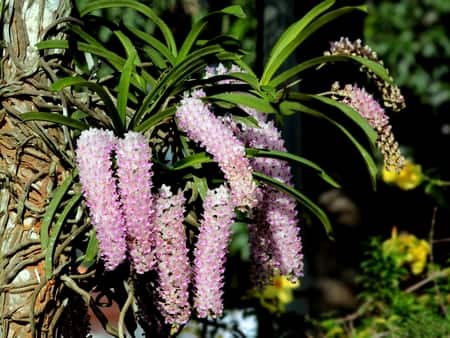
The first part of eliminating the problem is identifying who is causing it. If you aren’t quite sure what is on your orchid, this article about bugs that live in sphagnum moss may help.
There are many other types of insects that can live in orchid bark, leca, and coconut husks, too…but the majority will be in sphagnum moss.
The treatments to eliminate orchid plagues (pests, insects, bugs, fungus, bacteria, mold…anything that shouldn’t be there) are: neem oil, diatomaceous earth, hydrogen peroxide, isoporohoyl, Gnatrol, and Physan 20.
These products are easily found in most greenhouses and nurseries, since they aren’t’ orchid specific. Let’s look at these one by one.
1. Neem Oil – Used For Spider Mites
This pesticide is used mainly for spider mites, but can also be used in any critter that walks around on your plant. It is not toxic and will not harm the leaves, stem, or potting media. Neem oil consists of the sap of a palm tree found in India, named neem.
There are different components to neem oil, but the main one that keeps pests away is Azadirachtin. This is also widely used in crops and larger plantations.
It is 100% natural, but it does come with a horrid smell—a mixture of garlic and sulfur. It is not considered toxic to household pets, like cats, dogs, birds and small reptiles, but it will fill off fish. If your orchids sit next to an aquarium, it’s advised that you move it when using neem oil.
When you spritz or mist your orchid, the neem will slowly kill off the adult generation of bugs, so it has to be reapplied in a short period of time to kill off the eggs and larvae which have since grown. It’s better to consider neem oil as a repellent than as a pesticide, since it works better at keeping pests away than it does to eliminate the insect by death.
For this reason, neem oil is great to use if you have just spotted a few spider mites, rather than to use it on infestation of bugs on your orchid. If you repot only to find that your orchid medium is packed with mites and other critters, then neem oil is not the solution.
Your orchid will die before the product has time to effectively eliminate the critters. Neem takes a long time to actively work; by then, the insects have taken over.
Precautions to take when using neem oil: even though this product is 100%, the active chemical, Azadirachtin, when inhaled, can cause irritation to the lungs. If ingested, it can cause irritation to the stomach, but in all common sense, who is going to eat this?
Not even bees and birds eat it, that is why it’s not toxic to them. So use a mask when spraying your orchid, just to prevent the inhalation of fumes.
2. Hydrogen Peroxide – against thrips, aphids, spider mites, and bacteria
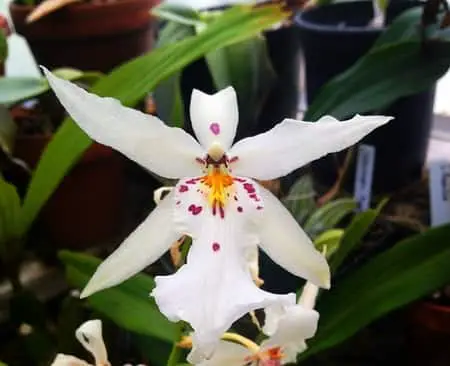
Hydrogen peroxide 3% is active against thrips, aphids, spider mites, and bacteria that causes brown spots and root rot. If you want more info on bacterial spots and what they look like read this article.
Hydrogen peroxide is commonly known for treating wounds and minor cuts, since the formula dissolves into water and oxygen.
It was first used as a disinfectant in 1977, and later introduced into crops in 1998 (more than 20 years later).
The free oxygen aerates the location it is applied, and in this case, is especially harmful to the bacteria and fungus infections on your orchid. The bacteria and fungi grow because of the lack of oxygen, so applying oxygen will hinder their growth. But hydrogen peroxide isn’t limited to bacteria and fungus. The larger pests, like thrips, aphids, and spider mites can all be physically removed when rubbing a cotton swab or cotton ball soaked with hydrogen peroxide over the leaves and stem.
When hydrogen peroxide is applied to roots that have black rot, of root rot, the solution will do two things. First, it will hydrate the root, since all roots need water, event he ones with root rot. The second quality, is that the hydrogen peroxide will aerate the root, providing a chemical exchange to remove the bacteria with and overdose of oxygen.
Root rot happens in the first place because of the lack of gas exchange in an over-watered medium. The buildup becomes toxic, damaging the roots. Hydrogen peroxide will aerate the roots, providing the much-needed oxygen to kill the bacteria.
This is the number one solution when dealing with poor roots, since we all have this around the house (especially if you have kids who are doing mischievous things.)
You can purchase a 35% solution of Hydrogen Peroxide, and even though this is used on crop production (diluted, not plain) this percentage is too strong for your orchid. If the 35% is the only one available in your location, then dilute it before applying.
3. Isopropyl Alcohol – (or rubbing alcohol) Used Against mealy bugs, spider mites, and aphids
Isopropyl Alcohol is used mainly against spider mites. You can read more about spider mites on this page.
This is also a very common household product, mainly used as an antiseptic. To apply isopropyl alcohol on your orchid, you’ll need to dilute it one-part alcohol to 9-parts water.
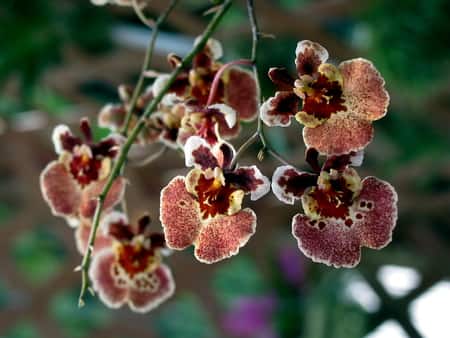
Beware though, if you apply a solution higher than 5%, then the orchid’s growth will stunt. At higher concentrations, around 25%, you will definitely kill your orchid.
Alcohol dissolves the insect’s protective coating and kills any larvae and eggs that come into direct contact with the solution. That’s why it’s so powerful in treating pests, bacteria, fungus, and insects.
On the downside, it also will burn the leaves, which is why you shouldn’t spray your leaves with alcohol then leave them in the direct sun. Always use a cotton swab or cotton ball and physically swipe the top of the leaves, removing any insects that you can see. Misting works for areas that are hard to get to, like the crown and new roots, but be careful not to overdo the misting. It’s too easy to get carried away.
Remove from direct sun, too, since the alcohol will promote leaf burn quickly.
Alcohol also has a high volatility, which means it evaporates quickly. This is especially good for killing insects and bugs because it will harm the protective coating, usually made of a waxy substance that alcohol dissolves, then it will remove the water inside the bugs body by evaporating quickly.
One substitution for alcohol is baby shampoo or mild soap. Both work just as well with this method, also diluted to the maximum that you can, yet still be effective. Test one leaf and see how your orchid reacts. Some shampoos and soaps can be harsher than others, so you don’t want to mist your whole collection without a good idea of how your orchids react.
4. Gnatrol – Against Fungus Gnats
Gnatrol is specifically used for fungus gnats. Fungus gnats aren’t really a problem, they are just an inconvenience, yet they point to a worse problem that is going unnoticed: fungus in your potting media. The gnats are attracted to the fungus and will appear if your potting media has a high rate of fungus to feed on.
If you want to read more, this article about fungus gnats should be helpful:
The presence of fungus gnats means that your orchid’s root have been rotting for a bit of time now, and you need to repot as soon as possible. The fungus has spread do bad that it has attracted gnats, who don’t harm your orchid at all. They actually do it a favor and digest the fungus. This would be well and dandy if the fungus didn’t grow faster than the gnats reproduced.
First, you need to repot, cut off all the old, dead roots, and treat the orchid for the black rot first. Once repotted in a new medium, with shorter but healthier roots, then you can use Gnatrol to rid any of the gnats that still linger around. The change in potting medium should be enough to naturally rid them, but they can be a pain sometimes if your orchid collection is large. They just fly from plant to plant searching for more fungus to feed on and new potting medium to lay their eggs.
This is where Gnatrol comes in handy. It is mixed into the water and added during watering. You’ll need to soak your plants in a tub of water (or sink) with a percentage of Gnatrol applied. This solution does nothing for the adult gnats, but it does kill the pupae and larvae that are inside the potting medium. The adults should go away once you’ve repotted anyway.
Since there are several different stages to the life cycle of gnats, you’ll need to do this treatment for three weeks to properly ensure that all the eggs have been killed off.
5. Physan 20 – Kills all Orchid Pests and Critters
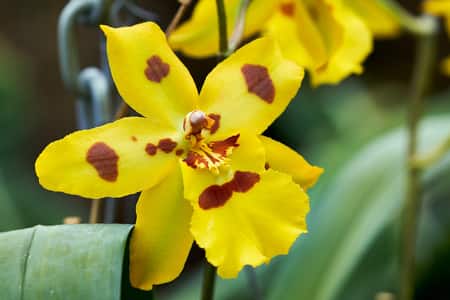
This product does it all. If you’re not sure what is on your orchid, then use Physan 20.
A little of this product goes a long way. This can be used both as a preventative method or an eliminating method, but I prefer it as preventive. Better to eliminate the problem before you even think you have one.
On the label, and this is copied right off their website, it says, “PHYSAN 20™ is a broad range disinfectant, fungicide, virucide, and algaecide which effectively controls a wide variety of pathogens on hard surfaces and plants. Its applications include greenhouses, hard surfaces, lawn and turfgrass, seedlings and cut flowers, decorative fountains, pools and birdbaths, and plants.” (Source: http://www.physan.com/)
You’ll need to dilute this as the instructions recommend, and use when repotting your orchid. It’s great to use on newly purchased orchids, too, since you never know what kinds of things they might have on them. To the bigger insects and pests, there’s no problem, but Physan 20 will eliminate all the ones you can’t see.
Usually it works with one tablespoon per galloon of water, and you soak the orchid roots in this solution from 2 to 5 minutes after you clean its roots. You can also mist the leaves, crown, and any little hiding place that bacteria and fungus might be lodged.
I’m a little skeptic about Physan 20 claiming it’s a virucide, since I personally have never seen a virus be killed with a product. Even with humans, virus are the ones that just can’t seem to stay under control, like HIV, Coronavirus, H1N1… and so on.
Bacterium can be dealt with using antibacterial, and fungus just feed off of bacteria, which can also be controlled. But viruses…? That’s another story.
But I won’t go against the product. Maybe with other plants that I’m not familiar with, they do extremely well with viruses. They have a whole product page on how to apply it with orchids, which you can read here .
.
5. Diatomaceous Earth – Springtails, Ants, Aphids, and any Larger Bugs
Diatomaceous Earth is the harshest of all chemical treatments on this page, and that is why I added it last to the list.
Use everything else first, and if those don’t work, this will. It will also be very hazardous to other critters in the wild, like birds, bees, cats, dogs…
So, keep it in a secluded area when applying, and always use masks and gloves.
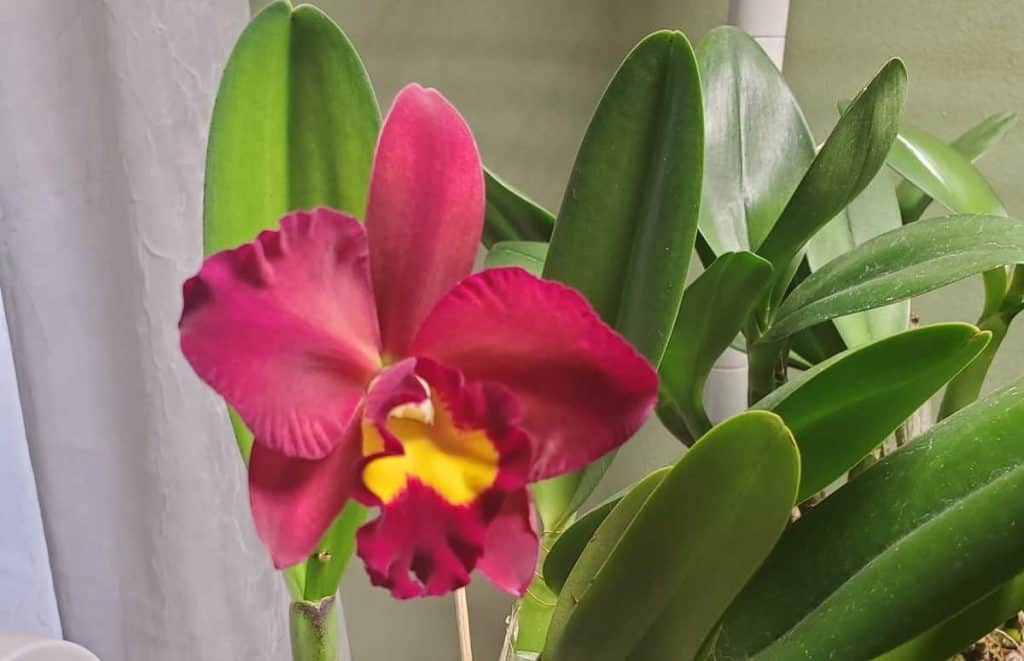
Cattleya Orchids
Why is this product so hazardous? Because it forms little knives and blades inside the digestive system that literally rip the insect apart from the inside. Diatomaceous Earth is silica fossils from earth, hence the name. It is ground up rocks, fossils, and minerals, forming microscopically laminated points. It can even contain quartz, glass, clay, and asbestos.
It is sold in the form of a powder, that you sprinkle on the top of your potting mix. They can kill most anything that will ingest it, like cockroaches, bed bugs, fleas, ticks, spiders and so on…but from an orchid point of view, is mainly used as a focus on springtails and ants.
Diatomaceous earth doesn’t have to be ingested by the insect to work. If inhaled, or if you rub your eyes, mouth, and nose while applying, then the damage can be extensive.
Needless to say, it doesn’t have to be ingested to work. Just coming into contact with the dry powder will irritate the skin and mucous membranes. The same applies to the insects and bug that walks across your potting medium. The microscopic blades rip apart the insect’s exoskeleton, and it dies from dehydration.
The powder will lose its effectiveness once it rains or gets wet. After you water your orchid, you’ll need to reapply the powder.If you’ve noticed, all the products above are either a pesticide, fungicide, or bactericide…formulated to kill bacteria or fungus. None of the products listed above are effective against viruses (well, except Physan 20). I have not yet found one single product that is effective against viruses, and for that reason, if your orchid gets contaminated by a virus, then sadly, toss it. But do it quick, before it contaminates your other plants.
Viruses are not curable (at least on orchids) and the risk of losing your whole collection is great. If you think your orchid has a virus, the most common is Ringspot virus. You can read more about Ringspot Virus here and see the symptoms and signs.
If you are reading this article and have read up to this point, then you probably have some kind of pest in your orchid and are looking for ways to eliminate it. I wish you all the best in killing that little critter, and keeping him away for good.
Don’t Stop Learning!
If you want to be included in more information and get a 14-page fertilization guide, please sign up for my newsletter. I don’t spam, but send emails out bi-monthly with some curious topics of interest. If you want more information, click here to go to a specific page on this website where I explain it more in detail.

Also, if you are looking for an orchid journal to keep your notes specifically about orchid care, check out my 2 solutions for that on this page. If note-keeping isn’t your thing, then there is a free excel spreadsheet that you can download. Click here for more information on how to do that.
If you subscribe to my newsletter, I will send you a 14-page guide on the main tips of orchid fertilizer. It is downloadable and you can print it out on your computer. I designed the guide to double up as a coloring book, just to make it fun.
If you use other products to cure bacteria, fungus, pests, insects, and bugs that isn’t mentioned here, please comment below. When we share information, we all grow and learn.
Happy Cultivating!


Physan is a fungicide and virucide in the same way bleach is; any virus that comes into contact will break apart, but if the infection is inside a plant, then you need antibiotics or antivirals to handle the infection.
I received a orchid plant as a gift with no flowers but told that when it blooms the flower will smell like chocolate…it did not come with a name and came from a private grower. I used a spray fertilzer for orchids on the leaves and 2 days later I am seeing tiny black spots on the top of the leaves. What can I do to stop it spreading?